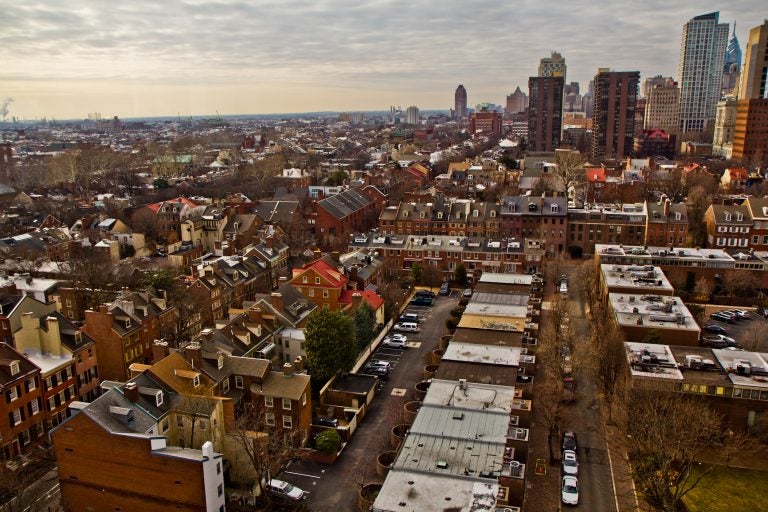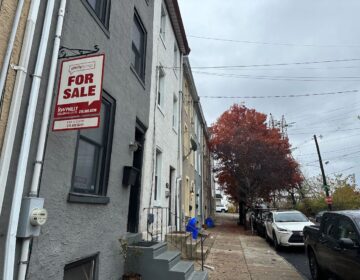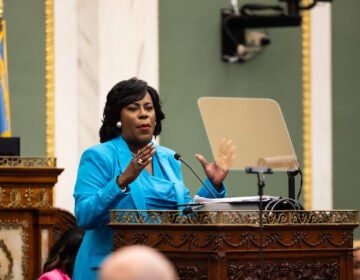How one of Philly’s richest neighborhoods is gaming the system
Society Hill’s proposed zoning overlay will exclude people and restrict development based on misrepresentation of history, a preservationist writes.

An aerial view of Society Hill. (Kimberly Paynter/ WHYY)
This Thursday, City Council will vote on a zoning proposal for Society Hill designed to restrict development and exclude new residents in the name of preservation. As a preservationist both familiar with Philadelphia’s architectural history and who believes in the field’s ability to do good, this bill is bad, NIMBY-driven policy that hinges on a misrepresentation of the area’s past.
Catering to wealthy residents of Philadelphia’s most storied unofficial gated community, the measures outlined in Bill 200094 include strict height restrictions, increased parking requirements, and the elimination of bonuses and exemptions meant to encourage historic preservation. If we were to speak the quiet part out loud, this bill is about maintaining the status quo that keeps the neighborhood more than 85% white, primarily single-family residential, and affordable to only a select minority of people.
These priorities undermine the urgent and necessary goals and values that should be driving city policy and historic preservation in 2020. As the encampments on the Benjamin Franklin Parkway and Ridge Avenue make abundantly clear, Philadelphia urgently needs to increase both naturally occurring and subsidized affordable housing. The city needs to support more sustainable and equitable transit-centric development, and, specifically, do so in wealthier neighborhoods that aren’t subject to the threats of gentrification and displacement.
Philadelphia City Council will likely vote to enact the bill, introduced by Councilmember Mark Squilla. Squilla reintroduced the zoning overlay in January, after it was vetoed by Mayor Jim Kenney at the end of his first term, and it passed unanimously through the council’s Rules Committee last week. Despite the fact that members of the council, the Philadelphia Planning Commission, and city residents, including other preservationists, have spoken against the proposal, Philadelphia’s tradition of councilmanic prerogative suggests it will pass.
Opposition aligns with comments made by the city’s director of planning and development, Anne Fadullon, in 2019, when she said its first iteration conflicted with the administration’s climate goals. She also called it blatantly exclusionary.
In response to last week’s recommendation by the Rules Committee, the urbanist political action committee 5th Square released a petition decrying the bill, encouraging people to testify at the City Council hearing on Thursday.
If passed, Bill 200094 would codify some of the recommendations laid out in the neighborhood master plan commissioned in 2018 by the Society Hill Civic Association, which calls for extensive downzoning. The bill would enact height restrictions between 45 and 65 feet in defined zones. Supporters of the plan and the bill paint an image of Society Hill as one of Philadelphia’s most pristine historic neighborhoods, citing its low-rise scale and prevalence of historic landmarks of modest height. But that idea rests on a faulty reading of history.
Like Independence Mall, Society Hill was selectively curated in the 1960s to clear blight — really, to displace lower-income residents living in tenement houses — and to highlight the city’s connection to the nation’s founders. That was done through a process of elimination: Federally funded bulldozers razed the visual clutter of more than a century of additions, subdivisions, storefronts, and commercial buildings. Though selective and extensive condemnation, demolition, modern construction, and mandated restoration, Society Hill’s real estate was processed through the mechanics of urban renewal and handed over to the “adventurous,” mostly white, upper middle-class at bargain prices backed by low-interest federal loans. Society Hill as we know it today is much more a product of 1960s urban renewal policy than 18th century Philadelphia.
Contemporary efforts to preserve its architectural “purity,” too, conveniently jump straight back to a romanticized image of the colonial past, painting the neighborhood as a sleepy, low-density residential area, sensitive to the threats of height, variations in land use, and the nuisance of unsightly bike infrastructure.
It’s not a stretch to say that Society Hill’s urban renewal story, and subsequent efforts to continue its exclusivity using “architectural character” as the principal excuse to gate-keep, represents much of what’s problematic about historic preservation. First off, the notion that density and mixed-use development don’t belong in Society Hill is historically incorrect — the area was highly commercial pre-urban renewal and prior to the 1960s, its rowhouses were often home to multiple families and businesses. Then there is the issue of impact: Wealthy neighborhoods like Society Hill are exactly where adding density and diversifying can provide housing for varying income levels without the threat of gentrification — something desperately needed in the city right now.
Councilmember Maria Quiñones-Sanchez, an outspoken proponent for affordable housing, expressed concerns about the bill, before voting in its favor as per the council’s vexing tradition of prerogative. “Society Hill is a neighborhood where we don’t have the level of affordability that we should,” Quiñones-Sanchez said. “We need to make sure that people understand that that is the spirit by which your Council colleagues support you on this issue.”
The argument for density
Increasing density in the form of apartments, accessory dwelling units, and mixed use projects — especially when they mandate long-term affordable units — in wealthier neighborhoods like Society Hill is imperative. While development advocates often paint added density as good across the board, it has the potential to have the strongest and least harmful impact in wealthier areas, especially if long-term affordable housing mandates are incorporated.
While in theory, increasing housing supply overall will ultimately reduce demand and lower prices, there are major caveats depending on the type of housing produced and where it’s located, particularly when considering the immediate impact on nearby residents. Adding luxury apartment buildings in lower-income neighborhoods may increase the net supply of housing, but it will also drive up prices and costs in the vicinity and it will often do so long before any trickle-down effects of increased affordability are felt. Adding a variety of housing types at varying income levels in a long-ago gentrified area like Society Hill, which has plenty of amenities and easy access to transit, doesn’t pose the same threat.
A microcosm of the debate around “appropriate” height and density has manifested recently over a proposed hotel at Walnut and Third streets that would replace a massive 1999 single-family residence. The Society Hill Civic Association, the National Park Service, and the Preservation Alliance all opposed the plans for a multi-story hotel, designed by Ambit Architecture to incorporate nods to the surrounding architectural character, citing its height and proximity to the Merchants’ Exchange building as the principal issue.
Though the proposed building height was reduced from 16 stories to seven, opponents say it still far exceeds the height limit proposed in the master plan, which tops out at 65 feet, or about five stories. Advocates on both sides worry that the outcome could set a troubling precedent. While the proposed design wouldn’t impact the affordability of the neighborhood, it’s not hard to imagine a scenario that included a higher density development with affordable units being met with the same scrutiny.
June Armstrong, a graduate student, Center City resident, and preservation and transit advocate summarizes issues with the proposed bill well. “It’s frustrating to see a bill that includes such incredibly restrictive zoning changes in the name of historic preservation, especially when other places are using those tools to fight inequality and climate change,” Armstrong said. “A bill that restricts height and design in such a centrally located, walkable, and transit-accessible area would be a huge setback for all residents of the city at the benefit of an elite few.”

Subscribe to PlanPhilly
WHYY is your source for fact-based, in-depth journalism and information. As a nonprofit organization, we rely on financial support from readers like you. Please give today.








